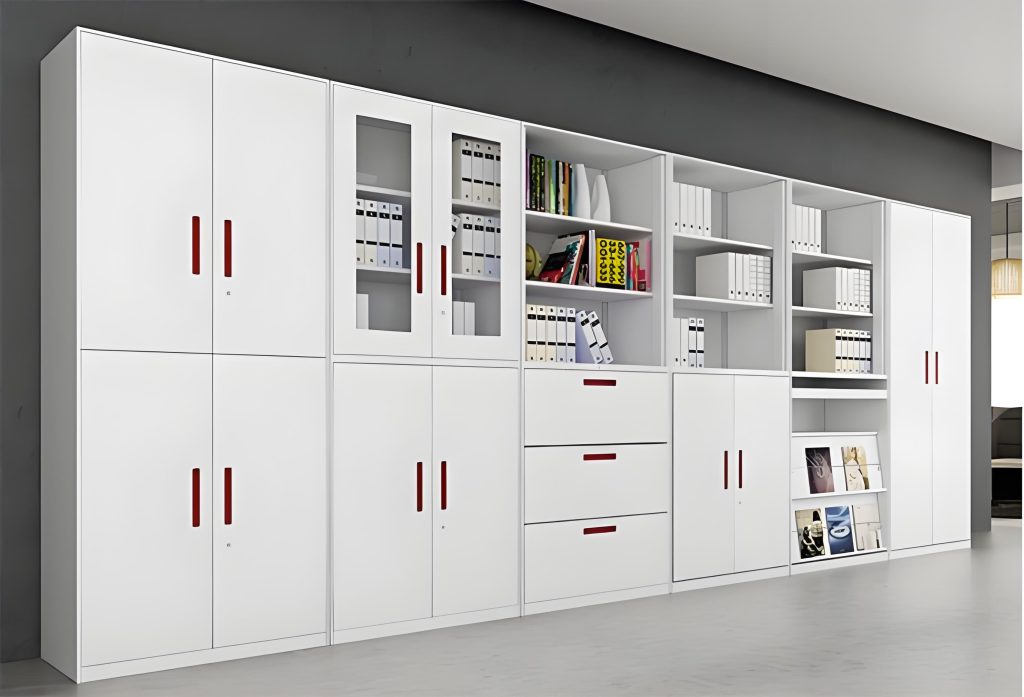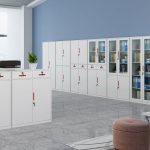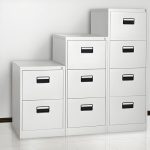
In an office environment, selecting the right office filing cabinet is crucial. A suitable filing cabinet not only improves work efficiency and optimizes space utilization but also impacts the overall image of the office. This article outlines five key factors to help you avoid common pitfalls when selecting an office filing cabinet and make an informed decision.
1. Clarify Usage Needs: Avoid Choosing the Wrong Type
1.1 Select Based on Storage Content
- General documents: Standard filing cabinets (height ≥ 300mm)
- Contracts and archives: Heavy-duty archival cabinets (steel plate ≥ 0.7mm)
- Financial records: Locking drawer filing cabinets (recommended 3-5 tiers)
- Sample displays: Glass-door display cabinets, such as transparent glass filing cabinets
1.2 Select Based on Frequency of Use
- High frequency: Sliding door or drawer-style cabinets (easy access)
- Low frequency: Swing door cabinets (space-saving)
- Long-term archiving: High-density mobile shelving (maximizes space efficiency)
1.3 Select Based on User Configuration
- Individual use: Small-sized filing cabinets
- Departmental sharing: Standard-sized filing cabinets
- Common areas: Modular filing cabinets (flexible configuration)
Pitfall Avoidance Tip: Before purchasing, assess the volume of documents and usage scenarios to avoid mismatched cabinet types that lead to wasted space or inconvenience.
2. Prioritize Material and Craftsmanship: Avoid Quality Traps
2.1 Material Comparison
- Cold-rolled steel: Durable, cost-effective, rust-resistant (suitable for general office areas)
- Stainless steel: Rust-proof, easy to clean, higher cost (ideal for humid environments)
- Solid wood: Premium, natural appearance, expensive, susceptible to moisture (suited for executive offices or high-end settings)
- Particleboard: Affordable, variety of styles, less durable (only suitable for temporary office use)
2.2 Key Craftsmanship Indicators
- Steel thickness: Cabinet body ≥ 0.6mm, drawers ≥ 0.5mm
- Surface treatment: Powder coating is superior to ordinary paint
- Welding Technique: Continuous welding > spot welding
- Lock quality: Copper core locks > zinc alloy locks
Pitfall Avoidance Tip: Don’t be lured by low prices. Inspect sample cabinets for details like edge finishing and smooth operation—areas where inferior cabinets often cut corners.
3. Dimensions and Space Planning: Avoid "Doesn’t Fit" Situations
3.1 Size Reference
- Single-door cabinet: Width 40-50cm × Depth 40-45cm × Height 70-180cm
- Double-door cabinet: Width 80-90cm × Depth 40-45cm × Height 120-180cm
- Drawer cabinet: Width 60-80cm × Depth 45-50cm × Height 70-120cm
3.2 Space Planning Tips
- Allow door clearance: Swing doors require 60cm of front space
- Consider aisle width: Main aisles ≥ 120cm, secondary aisles ≥ 80cm
- Check power outlet locations: Avoid blocking sockets
- Measure elevator/door sizes: Ensure smooth delivery and installation
Pitfall Avoidance Tip: Before purchasing, measure the installation area and create a simple layout plan, paying special attention to corners, doors, and windows that may affect usability.
4. Functionality and Ergonomic Design: Enhance User Experience
4.1 Practical Features
- Security needs: Electronic code locks > mechanical locks
- Moisture resistance: Elevated base design (≥ 10cm)
- Mobility needs: Wheeled base (easy relocation)
- Expandability: Stackable design
4.2 Ergonomic Details
- Rounded corners for safety
- Silent sliding rails (for drawers)
- Built-in dividers
- Cable management holes
Pitfall Avoidance Tip: Don’t overlook details—a poorly designed filing cabinet can become a daily frustration.
5. Budget and After-Sales Service: Consider Long-Term Value
5.1 Price Range Reference
- Economy tier: 300-800 RMB (basic functionality)
- Mid-range tier: 800-2,000 RMB (quality materials + features)
- High-end tier: 2,000+ RMB (customization + smart features)
5.2 After-Sales Service Considerations
- Warranty period: Reputable brands offer ≥ 3 years
- Delivery and installation: Check if included
- Spare parts availability: Ensure easy future purchases
- Maintenance response: Confirm service support
Pitfall Avoidance Tip: Look beyond the initial price. Calculate the 5-year cost of ownership (including maintenance and replacements) to choose the most cost-effective option.
Decision-Making Flowchart:
Define primary purpose → Determine location and dimensions → Set budget → Filter material types → Compare brands and features → Verify after-sales service → Final decision
A good office filing cabinet should be both practical and durable, serving as a reliable tool to enhance productivity. Before purchasing, compare multiple brands, inspect samples in person, and even trial use a cabinet if possible. By keeping the above points in mind, you’ll be able to select a filing cabinet that meets your needs perfectly.





